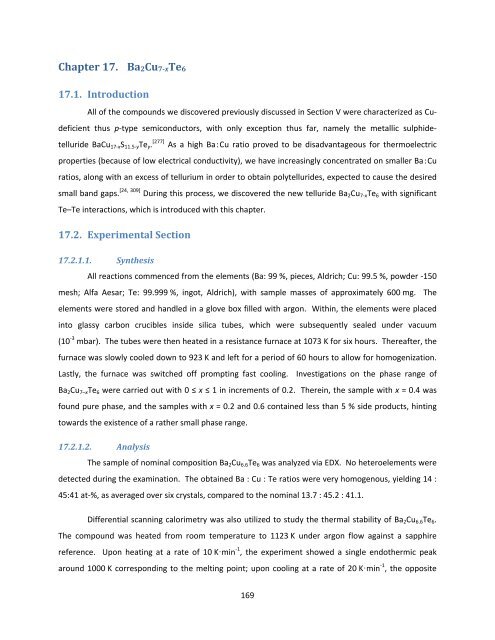Exploration and Optimization of Tellurium‐Based Thermoelectrics
Exploration and Optimization of Tellurium‐Based Thermoelectrics
Exploration and Optimization of Tellurium‐Based Thermoelectrics
You also want an ePaper? Increase the reach of your titles
YUMPU automatically turns print PDFs into web optimized ePapers that Google loves.
Chapter 17. Ba2Cu7‐xTe6<br />
17.1. Introduction<br />
All <strong>of</strong> the compounds we discovered previously discussed in Section V were characterized as Cu‐<br />
deficient thus p‐type semiconductors, with only exception thus far, namely the metallic sulphide‐<br />
telluride BaCu17‐xS11.5‐yTey. [277] As a high Ba:Cu ratio proved to be disadvantageous for thermoelectric<br />
properties (because <strong>of</strong> low electrical conductivity), we have increasingly concentrated on smaller Ba:Cu<br />
ratios, along with an excess <strong>of</strong> tellurium in order to obtain polytellurides, expected to cause the desired<br />
small b<strong>and</strong> gaps. [24, 309] During this process, we discovered the new telluride Ba2Cu7‐xTe6 with significant<br />
Te–Te interactions, which is introduced with this chapter.<br />
17.2. Experimental Section<br />
17.2.1.1. Synthesis<br />
All reactions commenced from the elements (Ba: 99 %, pieces, Aldrich; Cu: 99.5 %, powder ‐150<br />
mesh; Alfa Aesar; Te: 99.999 %, ingot, Aldrich), with sample masses <strong>of</strong> approximately 600 mg. The<br />
elements were stored <strong>and</strong> h<strong>and</strong>led in a glove box filled with argon. Within, the elements were placed<br />
into glassy carbon crucibles inside silica tubes, which were subsequently sealed under vacuum<br />
(10 ‐3 mbar). The tubes were then heated in a resistance furnace at 1073 K for six hours. Thereafter, the<br />
furnace was slowly cooled down to 923 K <strong>and</strong> left for a period <strong>of</strong> 60 hours to allow for homogenization.<br />
Lastly, the furnace was switched <strong>of</strong>f prompting fast cooling. Investigations on the phase range <strong>of</strong><br />
Ba2Cu7–xTe6 were carried out with 0 ≤ x ≤ 1 in increments <strong>of</strong> 0.2. Therein, the sample with x = 0.4 was<br />
found pure phase, <strong>and</strong> the samples with x = 0.2 <strong>and</strong> 0.6 contained less than 5 % side products, hinting<br />
towards the existence <strong>of</strong> a rather small phase range.<br />
17.2.1.2. Analysis<br />
The sample <strong>of</strong> nominal composition Ba2Cu6.6Te6 was analyzed via EDX. No heteroelements were<br />
detected during the examination. The obtained Ba : Cu : Te ratios were very homogenous, yielding 14 :<br />
45:41 at‐%, as averaged over six crystals, compared to the nominal 13.7 : 45.2 : 41.1.<br />
Differential scanning calorimetry was also utilized to study the thermal stability <strong>of</strong> Ba2Cu6.6Te6.<br />
The compound was heated from room temperature to 1123 K under argon flow against a sapphire<br />
reference. Upon heating at a rate <strong>of</strong> 10 K·min ‐1 , the experiment showed a single endothermic peak<br />
around 1000 K corresponding to the melting point; upon cooling at a rate <strong>of</strong> 20 K·min ‐1 , the opposite<br />
169
















